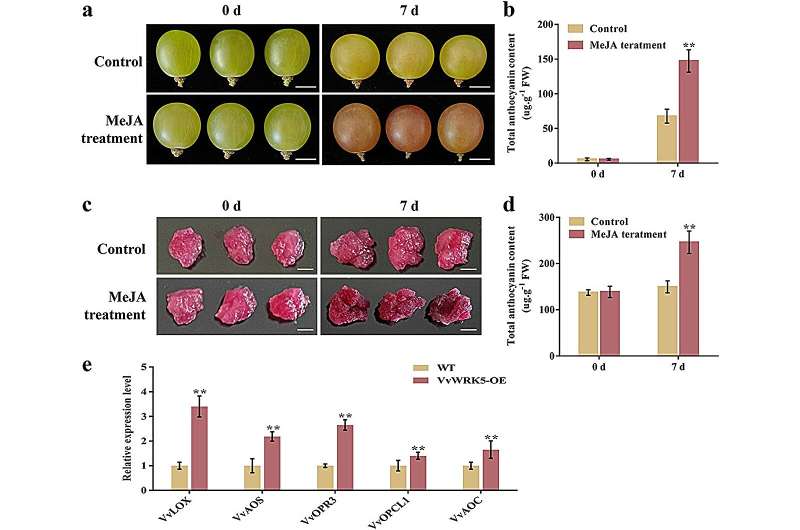This article has been reviewed according to Science X's editorial process and policies. Editors have highlighted the following attributes while ensuring the content's credibility:
fact-checked
peer-reviewed publication
proofread
Study reveals how wounding boosts anthocyanin in grapes

Anthocyanins are vital for plant defense, coloration, and attracting pollinators. They play a significant role in protecting plants from environmental stresses such as temperature fluctuations, drought, and pathogen attacks.
Despite their importance, the molecular mechanisms underlying stress-induced anthocyanin production remain unclear. Based on these challenges, there is a pressing need to conduct in-depth research on the factors that enhance anthocyanin biosynthesis, particularly under stress conditions, to improve crop quality and resilience.
A study published on March 25, 2024, in Horticulture Research, reveals the molecular mechanisms of wounding-induced anthocyanin accumulation in grapes. The research focuses on the transcription factor VvWRKY5 and its interaction with VvMYBA1 and jasmonic acid (JA)biosynthesis.
The study was conducted by researchers from the College of Horticulture at Shenyang Agricultural University and the National & Local Joint Engineering Research Center of Northern Horticultural Facilities Design and Application Technology in China.
The research identified VvWRKY5 as a crucial regulator in the enhancement of anthocyanin production in grapes under wounding stress. Upon wounding, the expression of VvWRKY5 significantly increased, leading to higher anthocyanin levels around the wound sites.
VvWRKY5 interacts with VvMYBA1, a well-known regulator of anthocyanin biosynthesis, enhancing VvMYBA1's ability to activate target genes involved in this pathway. Additionally, VvWRKY5 promotes the biosynthesis of JA, a phytohormone that further stimulates anthocyanin accumulation.
The combined action of VvWRKY5 and VvMYBA1 amplifies the grape's response to wounding, resulting in robust anthocyanin production. These findings demonstrate the dual role of VvWRKY5 in both direct gene regulation and hormone-mediated pathways, providing a comprehensive understanding of the molecular mechanisms behind stress-induced anthocyanin biosynthesis in grapes.
Dr. Yinshan Guo, a corresponding author of the study, states, "Our findings shed light on the intricate regulatory mechanisms of anthocyanin biosynthesis in response to wounding stress. Understanding these processes opens up new avenues for enhancing the stress resilience and quality of grape crops through targeted genetic and agronomic interventions."
The insights gained from this study can be applied to improve grape cultivation practices, enhancing the quality and stress resistance of grape varieties. By leveraging the regulatory roles of VvWRKY5 and VvMYBA1, breeders and farmers can develop strategies to boost anthocyanin content, leading to better fruit coloration and increased market value.
Additionally, this research provides a foundation for exploring similar mechanisms in other crops, potentially benefiting a wide range of horticultural practices.
More information: Zhen Zhang et al, VvWRKY5 positively regulates wounding-induced anthocyanin accumulation in grape by interplaying with VvMYBA1 and promoting jasmonic acid biosynthesis, Horticulture Research (2024). DOI: 10.1093/hr/uhae083
Journal information: Horticulture Research
Provided by TranSpread


















